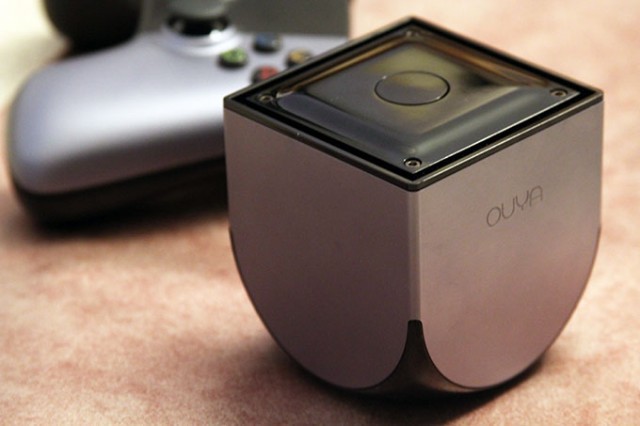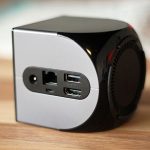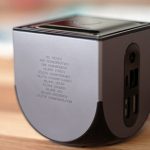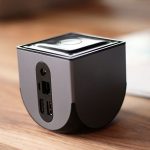
Ouya began shipping out early units to Kickstarter backers starting in March, and we got our hands on one such model about a month ago (Kickstarter units differ slightly from the final retail units, which we just got our hands on a few days ago and haven't had time to evaluate as fully). In that time, I've found myself addicted, quickly rushing through my day’s task list to get even just a few minutes to play a game. From emulators to the kind of independent games made by rookie developers with big ideas, Ouya's idea of gaming fits in perfectly in my living room. In fact, it's perched up right next to the rest of the consoles I own—which are collecting dust these days.
At $100, Ouya is practically an impulse buy even compared to aging consoles like the Xbox 360 and PS3 (to say nothing of this holiday's upcoming high-powered entrants). Still, that's money that could be otherwise put toward games for other platforms or newer, more powerful hardware. Is the Ouya just another gadget to tinker with and soon forget about, or is it a machine that will find its fit in your gaming life? To answer that, here's an idea of what it’s like to own an Ouya, with some insight into the games you can play and what lies ahead.
[h=2]A quick primer[/h]

These images were originally taken during our one-on-one chat with Ouya back at GDC in late March. The Ouya was just beginning to ship to its Kickstarter backers.
 These images were originally taken during our one-on-one chat with Ouya back at GDC in late March. The Ouya was just beginning to ship to its Kickstarter backers.
These images were originally taken during our one-on-one chat with Ouya back at GDC in late March. The Ouya was just beginning to ship to its Kickstarter backers.
 Here it is flipped on its side. You can see that it has an Ethernet port, as well as micro-USB, HDMI, and USB 2.0 connections.
Here it is flipped on its side. You can see that it has an Ethernet port, as well as micro-USB, HDMI, and USB 2.0 connections.
 Each Ouya backer unit features an inscription of its biggest backers. Notch, the creator of Minecraft, is the first on the list.
Each Ouya backer unit features an inscription of its biggest backers. Notch, the creator of Minecraft, is the first on the list.
 The Ouya controller is Bluetooth-connected and powered by two AA batteries. It also features a touchpad right above the right joystick and directional pad.
The Ouya controller is Bluetooth-connected and powered by two AA batteries. It also features a touchpad right above the right joystick and directional pad.
 Like the Ouya, the controller is also designed by Yves Béhar, a famous designer who has worked on products for companies like Samsung, Jawbone (where he is also chief creative officer), MINI, Prada, and General Electric.
Like the Ouya, the controller is also designed by Yves Béhar, a famous designer who has worked on products for companies like Samsung, Jawbone (where he is also chief creative officer), MINI, Prada, and General Electric.
 In the end, yes, it's a cube that plays games.
In the end, yes, it's a cube that plays games.
Physically, the Ouya is a remarkably small cube that fits easily in the palm of your hand. At 2.95 inches on each edge, it takes up much less total space in your entertainment center than even the diminutive Wii. It may stick out a bit in an entertainment setup, with a height that's much taller than a standard set-top box like the Roku and Apple TV. A simple, light-up power button sits on the top of the device alongside four screws that allow you to physically take it apart if needed (iFixit actually tore it down a while ago and reported that it is mostly repairable). It also features HDMI, micro-USB, and USB 2.0 connections on the back. Inside, it has a 1.7GHz Quad-Core ARM Cortex-A9 processor, 8GB of internal memory, and 1GB of RAM.
The Ouya comes with a packaged Bluetooth-connected controller, which takes a pair of AA batteries and feels exceptionally well-built (the unit also supports other Bluetooth devices, like a PS3 controller or USB controllers like the wired Xbox 360 controller). Overall, the pad will be familiar to anyone who has used an Xbox 360 controller, with two clickable joysticks, four face buttons (labeled O, U, Y, an A), and a pair of bumpers and triggers on each side. It's all placed almost identically to Microsoft's positioning. The main difference is a touchpad where the Xbox 360's start and back buttons are. This area works well, though it's distracting at times when you might accidentally bump it while reaching for another button.
The controller is extremely comfortable to hold for extended periods of time, due in part to the evenly distributed weight in both handles (each of which holds one of the two batteries). It also turns off quickly when not in use. I've been running on the same initial pair of batteries for nearly 30 hours, so you probably won't find yourself blowing through a bulk-sized pack of Duracells in a week's time. (The controller's lack of a rumble motor might have something to do with this extended lifetime.)
Ouya is primarily built on Android 4.1 Jelly Bean, but it’s so heavily skinned that you can’t tell you’re using Android until a rare installation prompt pops up or you get into the system settings. When you first push the power button on the box, it takes about 31 seconds before you see the minimalist menu screen. After that, navigating through the system's menus and launching games is practically instantaneous, though some games have their own internal loading routines.
From that opening menu, you have four different options. "Play" is a utilitarian, scrollable list of games you've currently installed, arranged in two long rows of rectangular icon. "Discover" is essentially the Ouya’s game marketplace, with multiple rows of categories intended to catch your eye. Some of them, like the Showcase categories, are confusing unless you’re aware of who is endorsing the games (for instance: InXile developer Brian Fargo or former Ars Technica writer Ben Kuchera). Other categories are a bit more straightforward, but the Discover area can feel crowded and overwhelming, even though there aren't that many games available yet (170 total, as of this writing). The Discover menu even has a "Sandbox" area where developers can upload pre-release editions of their games for Ouya players to try out, which encourages the "discovery" portion that this section is intended for.
 Downloads from the Discover screen start with just a couple of button presses, and they queue up in the background rather seamlessly. I was able to easily download five different games at a time while also downloading an update for a game that was already in my Play library. There was no separate download management screen to monitor the progress of current downloads, however. The only way to check up on the download status is to go into Discover and find the games' progress in each category, which became a bit frustrating as I grew more eager to play the games. (At least you can play other games while you're waiting.)
Downloads from the Discover screen start with just a couple of button presses, and they queue up in the background rather seamlessly. I was able to easily download five different games at a time while also downloading an update for a game that was already in my Play library. There was no separate download management screen to monitor the progress of current downloads, however. The only way to check up on the download status is to go into Discover and find the games' progress in each category, which became a bit frustrating as I grew more eager to play the games. (At least you can play other games while you're waiting.)Next up is Make, which could be considered the developer section of the console. This is where you can tinker with developer builds of games meant for Ouya, a feature we haven't actually used yet. It's also the place where you can sideload standard Android apps, like the ones you'd find on the standard Google Play store (which is not available directly on the Ouya). Sideloading a generic Android .apk file onto the system takes a bit of finagling, and once you get it on, there's no guarantee it will work like you expect. I've yet to try out anything beyond benchmarking applications and Dropbox, both of which worked fine.
The Make section also includes a very capable browser that can be navigated easily with the touchpad on the controller. Inputting URLs can be a bit of a hassle with just the joystick, but you can hook up a Bluetooth-connected keyboard if you're really aching to surf the Web on your TV.
 Enlarge / What Ars Technica looks like on the Ouya Web browser.
Enlarge / What Ars Technica looks like on the Ouya Web browser.Lastly, there’s the Manage section, which provides a very straightforward way to check on your Ouya account, link up controllers, check on the status of your network or system updates, and access the Android settings control panel.
[h=2]A familiar feeling[/h] Every game featured in the Ouya marketplace is free to download, either as a full game, a demo, or a title funded by microtransactions. Games like League of Evil will let you play up to a certain level before requiring you to pay the full price to unlock the rest of the game, while others like Stalagflight simply display a donations page asking you to contribute pizza funds if you want. You don't have to link a credit card account to start using the system if you don't plan on spending a dime, but you can input your payment information to make purchases instantly.
Many of the games in the marketplace are titles that were previously available on mobile devices, though I often found that I had more control in the game with a physical controller. Pix’n Love Rush, for instance, was easier to control with the tactile joystick and buttons than with virtual touchscreen controls. Other games like Saturday Morning RPG were a little unresponsive on a real controller, as the protagonist wouldn't always walk the right way, regardless of the direction I moved the joystick.
You'll also run into some games that look like they should have stayed on their original mobile platforms. Donut Get, in spite of its bugs, featured very simplistic, casual gameplay. The only requirement is to move a police officer around to catch donuts with his mouth. It's mindless fun that's well suited for a phone, but it doesn't work as well on a TV. The beauty of the free-to-play requirement, though, is that you can try everything out until you find something that you like.

[h=2]Looking forward to the future[/h] My biggest annoyance with the Ouya is having to constantly switch between a set-top box and the console. Both devices serve different purposes, but they shouldn't have to. The Ouya runs on an open source platform, and it almost feels like it should have more options for media streaming than it currently does. CEO Julie Uhrman hinted recently that video streaming apps like Hulu Plus and Netflix will be arriving on the console soon. For now, there isn't much in the way of media playback unless you want to go through the hassle of sideloading and setting up something like Plex or XBMC to play video. (The only official media offering right now is the Twitch.tv player.)
For the most part, the best part about the Ouya is its free-to-play game model and the seamless interface that makes it easy to try dozens of inventive games without much personal investment. Combined with the low asking price for the hardware, it could be a perfect system for kids. They can try out as many games as they want before asking their parents to purchase a few full versions at generally iOS-level pricing.
Even for those used to gaming on their PCs or Xbox 360s, Ouya brings a new gaming experience to the living room. Granted, it's a mostly smaller, independent experience, with some titles that are admittedly too casual to bother playing on a television screen. But the open nature of the Ouya affords it an endless array of possibilities. I could see developers releasing applications for the console that could eventually transform it into the type of media streaming box that the Xbox 360 is now. With its affordable price point and free-to-play model, it feels much more approachable for the casual gamer who isn't too interested in delving into triple-A titles.
(Kyle Orland contributed to this report)
